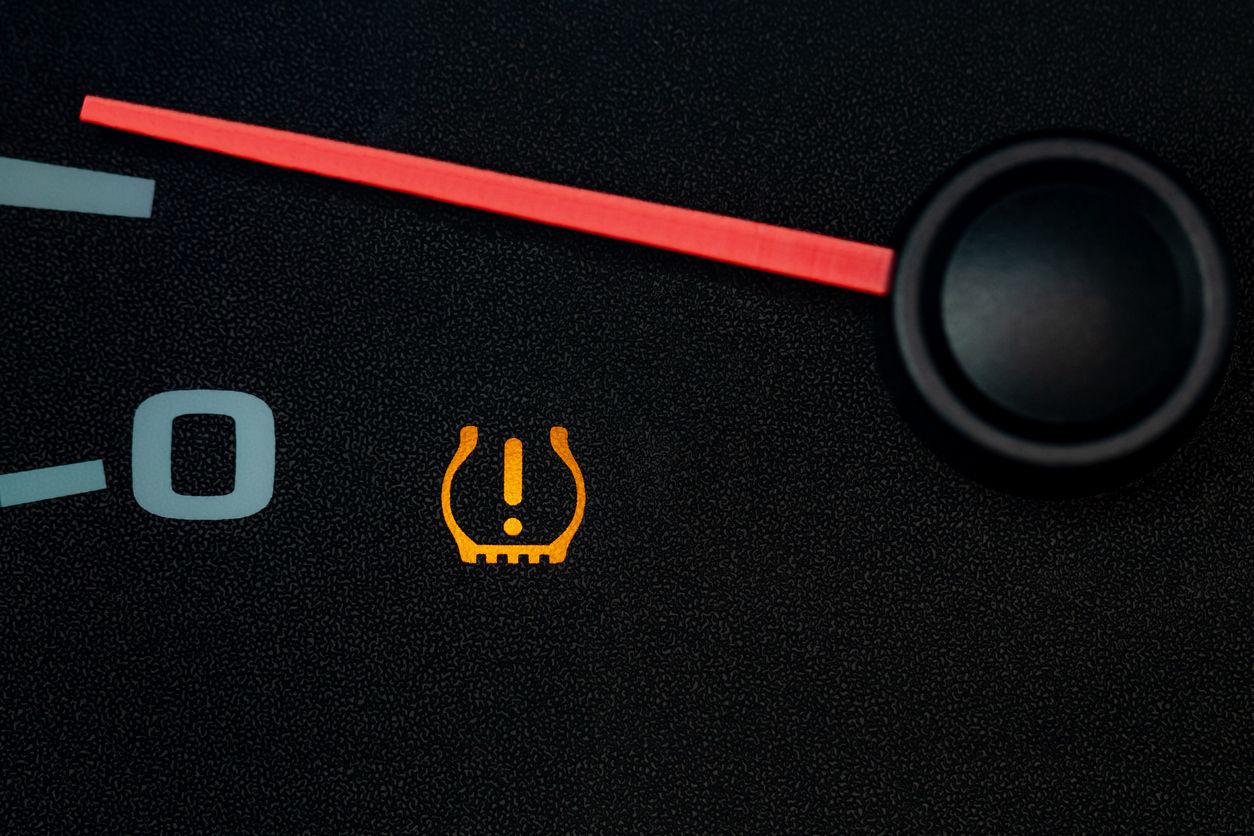A tire pressure monitoring system (TPMS) monitors air pressure levels inside your tires and warns you if a tire becomes significantly underinflated. Thanks to the TREAD Act, all cars made after 2007 are required by law to have this feature.
But how does a TPMS work, and how does it benefit your ride? Read on to learn all about tire pressure monitoring systems.
What Does a TPMS Warning Light Look Like?
You’ve probably seen the TPMS warning light illuminate on your dashboard when you start your car—it’s usually a yellow horseshoe-shaped tire with an exclamation point (!) inside. This important safety feature informs drivers when to top up the air in one or more tires.
TPMS DASH ICONS
This means that one or more of your tires is significantly under-inflated.
This means that the right front tire is significantly under-inflated. With the TPMS, one of these symbols will light up on the dashboard when any tire is 25% under-inflated.
The Main Benefits of TPMS
Your TPMS notifies you when your tire pressure is too low, so you can inflate your tires as needed. By helping you maintain proper tire pressure, your TPMS may improve:
- Safety: Properly inflated tires improve vehicle handling, braking, and are less likely to experience blowouts.
- Fuel economy: Underinflated tires increase rolling resistance, causing your vehicle to use more fuel than needed.
- Tire health: Underinflated tires wear out faster, especially at the edges.
- Brake system health: Properly inflated tires put less strain on your brakes by helping your tires maintain better traction.
How Does a TPMS Work?
A TPMS uses electronic sensors to measure tire pressure either directly or indirectly—known as direct TPMS and indirect TPMS. Every car made since 2007 has one of these two systems, but the sensors used in each system work differently.
How Does Direct TPMS Work?
Direct TPMS systems work by mounting pressure level sensors inside each of your car’s tires. These sensors directly measure each tire’s air pressure and transmit that data to your vehicle’s computer system.
When a sensor reads that its tire’s pressure has dropped more than 25% below the calibrated PSI, the TPMS light will appear on your dashboard. Depending on your vehicle, you might even see a pictogram on your dash depicting which tire is low and the current pressure of the other tires.
Since each tire has a sensor dedicated solely to monitoring tire pressure, direct TPMS systems tend to be more accurate. This accuracy does come with additional cost, though. Direct TPMS can be slightly more expensive to maintain because they may require a new valve service kit each time a tire is dismounted or replaced during servicing. Plus, a special TPMS tool and additional time are often needed to check sensors and reset tire pressure calibration for each one.
How Does Indirect TPMS Work?
Instead of a pressure sensor at each wheel, indirect TPMS works by measuring wheel speed through the Anti-lock Braking System’s (ABS) sensors. In this system, your vehicle’s computer tracks and compares the rate of revolution across all four tires to see if one wheel is spinning faster than the others. A tire that is underinflated will have a shorter diameter compared to properly inflated tires, resulting in a faster spin rate. When the wheel speed sensors detect this, the ABS will signal your onboard computer to activate the TPMS warning light.
Vehicle manufacturers developed indirect tire pressure monitoring systems as a more affordable way to comply with the TREAD Act. Instead of adding specialized TPMS sensors in each wheel assembly, they rely on existing sensors in your brake system.
Need help identifying which system you have or want to learn more? The technicians at your local Firestone Complete Auto Care are ready to answer any of your questions.
What to Do If Your TPMS Comes On
If your vehicle’s TPMS warning indicator light comes on—and stays on—you have a tire pressure problem. Check the air in all your tires using a tire pressure gauge, find the underinflated one, and inflate the low-pressure tire back to the recommended PSI. You can find the recommended PSI listed on the driver’s side door jamb of your vehicle or in your car owner’s manual. To avoid future TPMS alerts, check your tire pressure monthly and top up tires as needed.
Seeing the TPMS warning light a little too frequently? This could indicate a puncture or slow leak in your tire. If you think you might be dealing with a leak, schedule an appointment at Firestone Complete Auto Care. We’ll check your vehicle’s tire pressure and perform a systems test on your TPMS sensors to diagnose the problem if needed.
Keep Your Car’s TPMS Road-Ready at Firestone Complete Auto Care
Whether it’s a tire pressure issue or a system malfunction, don’t ignore your TPMS warning light! Maintaining your TPMS is crucial to keeping your passengers safe and your car in the best condition.
TPMS service requires a special tool and a reset of your vehicle's sensor system, so schedule a service appointment at Firestone Complete Auto Care and leave it to the pros to get to the root of the issue. We carry high-quality TPMS sensors for almost any vehicle to get you back to safe driving sooner.
TPMS Frequently Asked Questions:
Why is My TPMS Light Blinking?
A flashing tire pressure light typically means the TPMS has detected a problem with the system itself rather than an underinflated tire. This usually indicates there is some kind of sensor malfunction or communication issue with the vehicle’s computer. If the TPMS light continues to blink each time you start your car, it’s time to have the system inspected.
What Does Check TPMS System Mean?
Receiving a “Check TPMS System” alert is different from the usual yellow TPMS warning light and indicates there may be a problem with the TPMS itself. Oftentimes this is the result of a dead sensor battery preventing the TPMS from accurately reading tire pressure levels.
If you get this alert, head to your nearest Firestone Complete Auto Care for a TPMS service. Our trained technicians will diagnose and replace any faulty components if needed.
Why is My TPMS Not Working?
If your TPMS is not working, the likely cause is a malfunctioning sensor due to damage, corrosion, or simply a dead sensor battery. If your tire pressure is extremely low and you never received an alert from the TPMS, you should have the system inspected and serviced promptly.
Why Does My TPMS Light Come On When It’s Cold?
Extreme temperature changes can cause tire pressure to fluctuate. Colder temperatures cause the air in your tires to contract, often lowering the pressure level. If your tires are only slightly underinflated, you may find that your TPMS light disappears once the tires heat up from driving.
Will My TPMS Light Come On If My Tires Are Overinflated?
Many vehicles will trigger the TPMS light whether tire pressure is 25% under or over the recommended pressure level, though this depends on your specific manufacturer. Similar to low-pressure tires, extremely overinflated tires can adversely impact your car’s handling, tire wear, and brake system.
What Does TPMS Calibration Mean?
TPMS calibration refers to syncing your TPMS sensors to your tires' position on the vehicle and resetting the system after service or repair has been performed to turn off the TPMS warning light. Recalibrating or resetting your TPMS is usually necessary after tire rotations, changing tires, or if your sensors provide inaccurate readings.
Do Spare Tires Have TPMS?
Most spare tires lack a TPMS sensor and will not work with the TPMS. Using a spare, however, may cause the TPMS light to appear until the spare is replaced with a full-size tire that has a sensor.
Depending on the manufacturer, some full-size spares come with a sensor that will work with your TPMS.
What Are TPMS Sensors?
TPMS sensors are small devices mounted inside your tires that monitor air pressure and send that data to your car’s computer. These sensors are calibrated to a specific PSI and trigger a TPMS warning light when pressure levels inside your tires become too low or too high.
How Long Does a TPMS Sensor Last?
TPMS sensors typically last 7 to 10 years, but they may die earlier due to extreme weather conditions or damage or corrosion. The sensor battery is not replaceable and requires a full sensor replacement once the battery dies.
When one sensor battery dies, the others are likely not far behind. To maintain accurate pressure readings, consult with the experts at Firestone Complete Auto Care about changing all TPMS sensors at the same time. In the long run, this can give you peace of mind and prevent you from making numerous trips to your local repair facility, even though we would appreciate seeing you again..
Does Firestone Replace TPMS Sensors?
Yes! We carry only the highest-standard TPMS sensors. If your tire pressure light blinks every time you start your car or won’t go away after inflating your tires, bring your car in for a TPMS service—the trusted technicians at Firestone Complete Auto Care have you covered.



